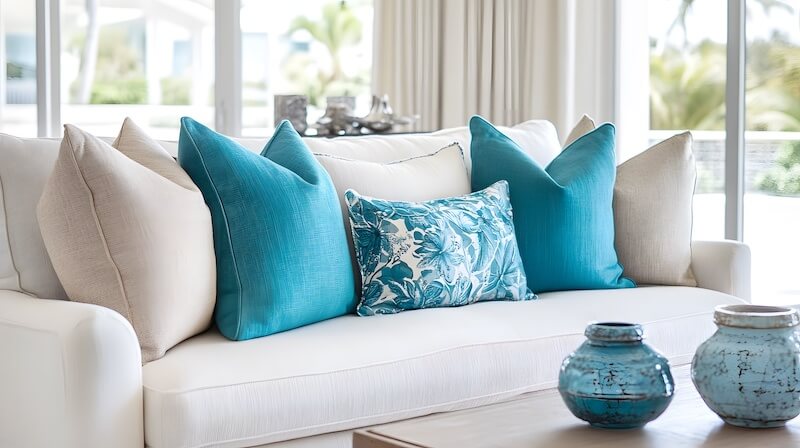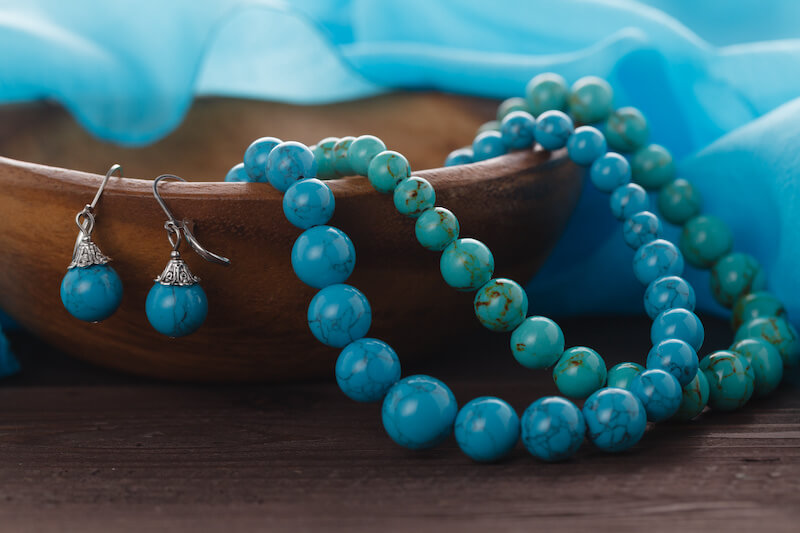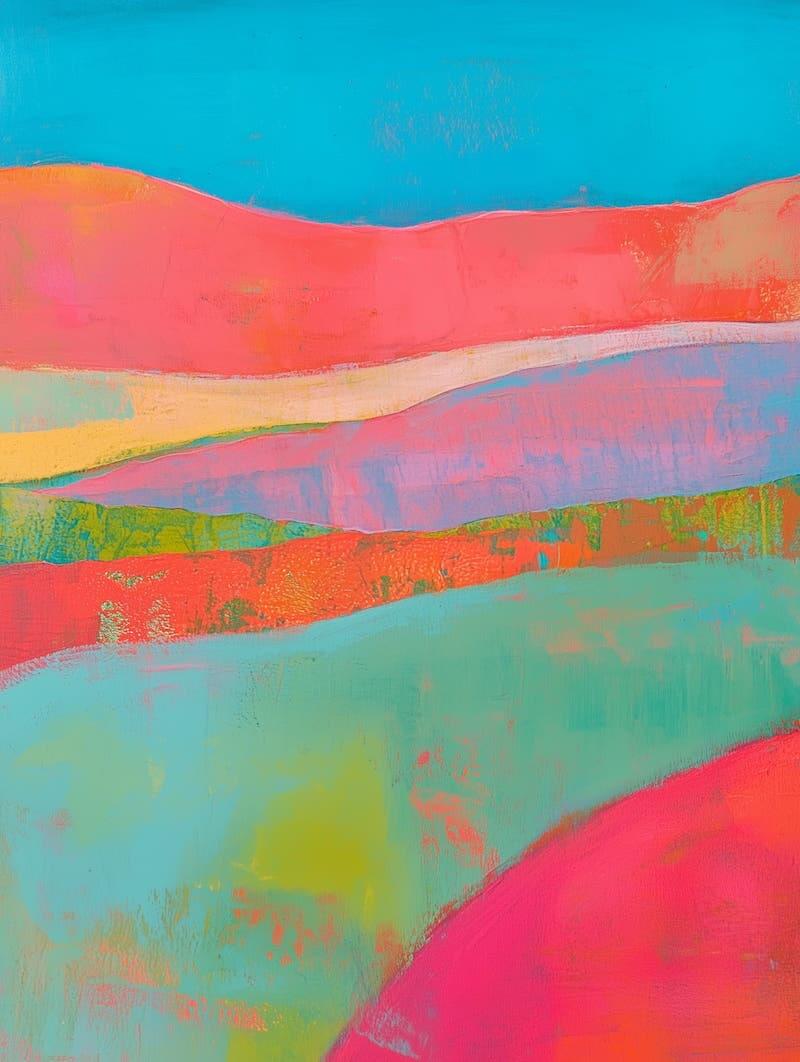Turquoise sits right between blue and green on the color wheel. Think ocean waves and clear skies. It’s both calm and full of life at the same time.
But what does this vibrant shade actually do to us?
Does it make rooms feel bigger? Help you sleep better? Change how you feel?
From ancient jewelry to modern paint choices, turquoise works on our brains in surprising ways. Let’s explore the meaning of this happy color and what happens when you use it to decorate your home.
Quick Turquoise Psychology Tips
Don’t have time to read everything? Here’s what you need to know about how turquoise can change the mood in a room:
- For emotional balance—Use soft turquoise in bedrooms and bathrooms
- For fresh energy—Add bright turquoise pops in living rooms and kitchens
- Boost creativity—Put turquoise accents in your office
- Find your focus—This color helps with clear thinking
Share these tips with a friend who’s thinking about repainting or adding new decor!
What Makes Turquoise Special?

Turquoise isn’t just blue. It’s not just green either. It sits right in the middle, taking the best from both.
From blue, it gets calm, peaceful vibes. From green, it gets energy and life. People sometimes confuse turquoise with aqua, but turquoise has more warmth and green undertones.
When you put turquoise in a room, you’re not just picking a pretty color. You’re adding something that works in two ways. It calms you down but doesn’t make you sleepy.
This mix makes turquoise perfect for almost any room. Bedrooms? Yes. Neutral kitchen spaces? Absolutely. Traditional setting? Works great there too.
Designers love this color palette for spaces where you want to feel both relaxed and refreshed. Think about how you feel looking at a tropical beach—that’s the turquoise effect.
How Turquoise Changes Your Mood

Ever notice how some colors just make you feel different? Turquoise does this better than most.
It helps with emotional control. When you’re stressed, it calms you down. When you’re sluggish, it perks you up. Not many colors can do both.
Feeling stuck on a problem? Turquoise helps with clear thinking. It cuts through mental fog and helps you think straight. That’s why it’s great in home offices or study areas.
Got creative block? Turquoise jumps your brain into fresh thinking. It’s like a gentle nudge toward new ideas.
Need to talk through something tough? This color helps with that too. In many ancient beliefs, turquoise connects to the throat—the center of honest talk and clear words.
Even your body responds to it. Your breathing might slow down. Your shoulders might drop away from your ears. Tension melts.
This vibrant shade brings emotional balance. Not too hot, not too cold. Not too loud, not too quiet. Just right.
Decorating Your Home With Turquoise

Ready to bring turquoise into your interior design? Smart move.
Start with a small amount if you’re not sure. A few turquoise pillows on a grey couch. A painted side table. Some artwork with ocean blues.
Or go bold with a turquoise accent wall. Behind your bed, it helps with sleep. In your living room, it makes the space pop.
Pair it with simple colors to create a balanced palette:
- Crisp white makes turquoise look clean and fresh
- Neutrals soften the style
- Grey creates a modern vibe
- Yellow adds a sunny feel to this cool shade
Want something more exciting? Try turquoise with coral or orange. These vibrant color combinations sing together.
In a neutral kitchen, turquoise backsplash tiles wake up boring white cabinets. In bathrooms, it brings that spa feeling home.
Turquoise in Jewelry and Fashion

Turquoise isn’t just for walls. People have worn this gemstone for thousands of years.
Ancient Egyptians buried their dead with turquoise for protection. Native American tribes used it in sacred art. Persian kings put it in their crowns.
Today, turquoise jewelry does more than look pretty. A necklace or bracelet gives any outfit instant personality.
Wearing turquoise near your face brightens your skin tone. It makes your eyes pop. It says you’re confident but not shouting for attention.
Not ready for turquoise clothes? Start with small touches. A scarf. Some earrings. Even turquoise-colored shoes can make a basic outfit come alive.
The best part? This color looks good on everyone. Every skin tone. Every age. It’s one of those rare universal shades.
Creating a Turquoise Color Scheme

Want to build an interior design color scheme around turquoise? Here’s how to do it right.
First, pick your saturation level. Light turquoise feels airy and open. Bright turquoise brings energy. Darker shades add drama.
Then choose a main partner for your color palette:
- White + turquoise = clean, beachy vibes
- Grey + turquoise = modern, calming space
- Neutrals + turquoise = earthy, grounded feel
- Coral + turquoise = fun, playful energy
- Orange + turquoise = bold, striking contrast
- Yellow + turquoise = fresh, cheerful look
Add a few neutrals to keep things balanced. Some wood tones. A bit of white. Maybe some black for grounding.
For a Southwestern color palette, mix turquoise with terra cotta and yellow. For beach vibes, pair with beige and white. For a jewel-box effect, try turquoise with dark purple and gold accents.
Simple Ways to Add Turquoise Now
Not ready for painting? No problem. Try these quick turquoise additions:
- Throw pillows on your sofa or bed
- A painted picture frame
- Small plants in turquoise pots
- Kitchen towels or oven mitts
- A turquoise throw blanket
- Bathroom towels
- A painted side table
- Turquoise drinking glasses
- A table lamp with a turquoise base
- Small art pieces with turquoise tones
Start with one or two items. See how they make you feel. Notice if your mood shifts when you enter the room.
That’s the magic of turquoise—it works whether you have a little or a lot.
In any traditional setting, a pop of this vibrant shade brings life and energy. In modern rooms, it adds warmth and personality.
Turquoise brings emotional balance and clear thinking at the same time. It helps you focus while lifting your spirits. Not many colors can claim that special power.
Ready to bring some turquoise home?




